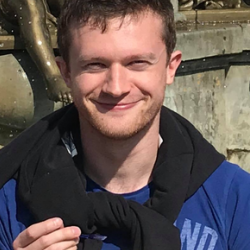Research
TL;DR:
- Automatic microearthquake detection & location
- Waveform cross-correlation & relative relocation
- Swarm seismicity
- Conjugate strike-slip faulting
- Seismicity rate changes caused by static stress changes
- Dike-induced seismicity
- Caldera collapse seismicity
- Local travel-time tomography
- Relative seismic velocity changes (dv/v)
- Seasonal variations in earthquake rates
- Earthquake coda-wave interferometry
I study microseismicity caused by tectonic spreading and volcanic & geothermal processes in central Iceland. Over the past 2 years I have helped develop the QuakeMigrate python package for earthquake detection and location, which is used to efficiently detect and locate earthquakes down to very low magnitudes (ML ~ -0.5) and build a highly complete seismic catalogue. Using the data recorded by the Cambridge network since 2007, I analyse patterns in the rates, mechanisms and style of seismicity over more than a decade, which has included two large dike intrusions and ongoing intense tectonic seismicity caused by plate spreading.
My work has revealed that plate spreading in the region between the Askja and Herðubreið volcanoes is accommodated by conjugate strike-slip faulting, rather than normal faulting. Furthermore, slip events on these faults do not exhibit the normal pattern of a relatively large-magnitude mainshock followed by smaller aftershocks, but slowly migrating swarms of small-magnitude earthquakes. Refinement of the earthquake locations by waveform cross-correlation and relative relocation has revealed this phenomenon in unprecedented detail, providing a new insight into the exciting new field of dominantly aseismic fault slip. These faults were strongly affected by the static stress change imparted on this region of the crust by a dike intrusion from Bárðarbunga in 2014; by comparing the changes in seismicity rates to the evolution of the induced stress field I have been able to place further constraints on their mechanical properties.
The same workflow has allowed us to resolve the nature of the dike-induced seismicity during the 2014-15 Bárðarbunga-Holuhraun dike intrusion, and decipher its relationship to the background stress-field and the stresses produced by the dike opening. I am interested to investigate how the lessons learned here apply to other examples of well-recorded dike intrusions globally.
Over the course of the subsequent 2014-15 eruption, Bárðarbunga's caldera subsided by over 60 m, leading to a long period of intense seismicity including a series of large ring-faulting earthquakes with MW > 5. Until 2018 (!) this was by far the best geophysically recorded example of a caldera collapse worldwide. We have produced a high resolution image of the relative distribution of the smaller earthquakes, revealing the shape and size of the ring-faulting structure. I am currently working to improve the constraints of these results, by including the data since the eruption ended, as Bárðarbunga has begun to re-inflate, and refining the velocity model with local travel-time tomography.
I am also interested in making continuous measurements of the relative seismic velocity of the crust using earthquake coda-wave and ambient noise interferometry. Ambient noise dv/v measurements in the region of our network also show a clear response to the stress changes induced by the 2014 dike intrusion, but are dominated by an annual cycle. We have successfully modelled this as a response of the crust to seasonally varying snow & atmospheric load and crustal pore-pressure. I am investigating whether this same model can explain the observed seasonal variation in earthquake rates at the shallow geothermal area of Askja volcano. I also plan to use this long time series of similar events to make a second set of dv/v measurements, allowing me to compare the sensitivity kernels of the noise- and earthquake-based techniques.
Publications
Winder, Tom and Bacon, Conor A. and Smith, Jonathan D. and Hudson, Thomas S. and Greenfield, Tim and White, Robert S., 2019. QuakeMigrate: a Modular, Open-Source Python Package for Earthquake Detection and Location. AGUFM, 2019, pp.S53B-05.
Donaldson, Clare and Winder, Tom and Caudron, Corentin and White, Robert S. (2019) Crustal seismic velocity responds to a magmatic intrusion and seasonal loading in Iceland's Northern Volcanic Zone. Science Advances, 5 (11). ISSN 2375-2548 DOI https://doi.org/10.1126/sciadv.aax6642
Ágústsdóttir, Thorbjörg and Winder, Tom and Woods, Jennifer and White, Robert S. and Greenfield, Tim and Brandsdóttir, Bryndís, 2019. Intense Seismicity During the 2014–2015 Bárðarbunga‐Holuhraun Rifting Event, Iceland, Reveals the Nature of Dike‐Induced Earthquakes and Caldera Collapse Mechanisms. Journal of Geophysical Research: Solid Earth, 124(8), pp.8331-8357. ISSN 2169-9313 DOI https://doi.org/10.1029/2018JB016010
Winder, Tom and Woods, Jennifer and White, R.S. and Brandsdóttir, Bryndís, 2019. The importance of pre-existing structures and stresses to dike-induced earthquakes: The 2014–15 Bárðarbunga–Holuhraun rifting event, Iceland. In Geophysical Research Abstracts (Vol. 21).
Woods, Jennifer and Winder, Tom and White, Robert S. and Brandsdóttir, Bryndís, 2019. Evolution of a lateral dike intrusion revealed by relatively-relocated dike-induced earthquakes: The 2014–15 Bárðarbunga–Holuhraun rifting event, Iceland. Earth and Planetary Science Letters, 506, pp.53-63. ISSN 0012-821X DOI https://doi.org/10.1016/j.epsl.2018.10.032
Greenfield, Tim and White, Robert S. and Winder, Tom and Ágústsdóttir, Thorbjörg, 2018. Seismicity of the Askja and Bárðarbunga volcanic systems of Iceland, 2009–2015. Journal of Volcanology and Geothermal Research, 391. ISSN 0377-0273 DOI https://doi.org/10.1016/j.jvolgeores.2018.08.010
Winder, Tom and White, Robert S. and Green, Robert G. and Greenfield, Tim, 2018. A Surge in Seismicity in a Network of Cross-Cutting Conjugate Strike-Slip Faults Triggered by the 2014 Bárðarbunga-Holuhraun Dike Intrusion. AGU Fall Meeting Abstracts, 2018, pp.V23C-08.
Ágústsdóttir, Thorbjörg and Woods, Jennifer and Greenfield, Tim and Green, Robert G. and White, Robert S. and Winder, Tom and Brandsdóttir, Bryndís and Steinthórsson, Sveinbjörn and Soosalu, Heidi, 2016. Strike‐slip faulting during the 2014 Bárðarbunga‐Holuhraun dike intrusion, central Iceland. Geophysical Research Letters, 43(4), pp.1495-1503. ISSN 0094-8276 DOI https://doi.org/10.1002/2015GL067423

